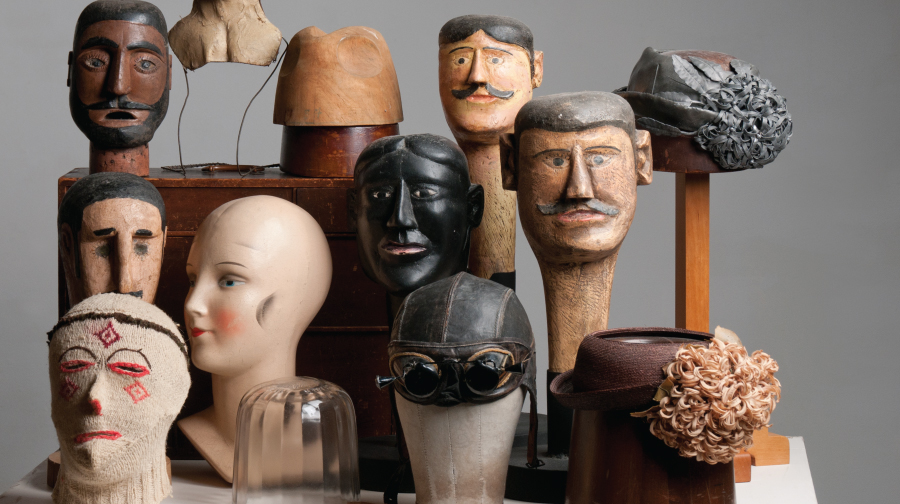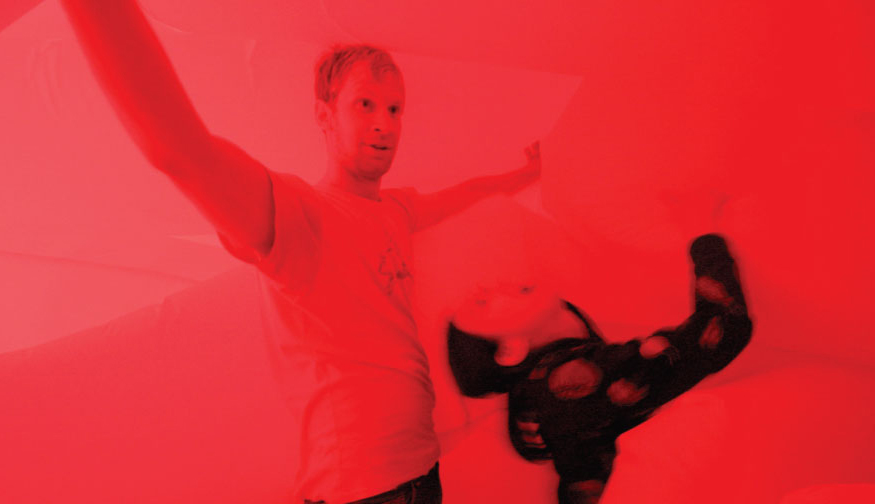

To spend an afternoon with Marilyn Lanfear is to experience the same rich sense of anticipation one feels when diving into an absorbing novel: It won’t be dull, and the journey will be worth pondering long after the last page has been turned.
Lanfear—painter, sculptor, woodworker, collector—is as much a storyteller as an artist, and the materials she uses to tell her stories depend completely upon which ones best achieve her vision.
"I don’t just keep painting with oil paints and then get better and better," she said. "I usually get my idea and then I have to learn how to make it visible. If I need to learn to carve, I have to learn to carve. But the trouble is, I have to learn how to do it as if I’ve been doing it for years and years."
In 1976, Lanfear was the first B.F.A. graduate at UTSA, and in 1978 she was one of five students awarded an M.F.A. That year, a total of 12 students received arts degrees. By contrast, 597 students have received a bachelor’s or master’s degree in the arts in the last eight years, an indication of how the Department of Art and Art History has expanded, according to department chair Greg Elliott.
"The growth rate in the department is enormous," Elliott said. "A lot of that, I think, is due to the fact that we have a program that still very much honors the traditional approaches to studio art–object–making and image–making–but the faculty here and the program itself are committed to staying extremely current."
Art isn’t just the traditional bronze, oil paint, ceramics and lithography anymore, he added. Today’s art also involves performance and installation and videos. Graduates continue to create and stay relevant, he said.
Take Jimmy Kuehnle, who graduated with an M.F.A. in 2006. He doesn’t shy away from attention. In fact, his most recent work is hard to miss. The performance artist and sculptor designs and fabricates inflatable nylon suits and wears them in public. The response he gets to the absurdity of his suits is the point behind the work.
Kuehnle, now an assistant professor at the Cleveland Institute of Art, made his first inflatable suit, Kiss the Sky, for a Houston performance while he was a graduate student at UTSA.
"I filled it up with air and I had a big extension cord and an air blower and ran all around and asked, ‘Hey I need electricity. Can you help me?’ I would unplug and then run down the street to the next person to see if they would give me electricity to stay inflated. It was really fun."
Then there’s Nate Cassie, whose latest project is called Vacancy, in which he curates one-night exhibitions held in vacant spaces made available for the show.
At a recent exhibition, he wore a "Head Curator" nametag as he consulted with "clients" perched on his barber chair. As he discussed their style options, Cassie pulled out a camera to take before and after shots. The mirrors on the wall were warped, ensuring that no customers would get a clear view of their new ’dos.
"I have always wanted to have a barbershop," he said. "I like [that] it has this intimacy and a communal aspect. It’s part of your head that you are exposing to somebody and if you are a man of a certain age, maybe you are losing some hair up there. There’s a lot there [to work with]."
The department’s graduates stay busy, whether it is creating multimedia art objects with buttons like Lanfear, crafting absurdist inflatable suits like Kuehnle, or teaching and creating art, like sculptor Cassie.
"We get lots of show flyers. I’ve got a big drawer full of them," Elliott said. San Antonio has a tradition of celebrating art on the first Friday of every month with an art walk in galleries south of downtown. "It is not uncommon for every First Friday that I’ve got 10 to 12 shows to go to and eight of them will be somebody from UTSA."
And UTSA’s visibility is growing every year, he added. "We’ve got a huge presence in a very active art community here and that’s not accidental. It’s been a mission of the department for 20 years; our students were not going to study [art], they were going to go out there and participate before they graduate."

From an early age, Lanfear knew she wanted to be an artist. Born in Waco, her family moved to Corpus Christi when she was in the sixth grade. After earning her M.F.A. from UTSA, Lanfear left San Antonio for New York City to pursue her dream of working in what she calls "Mecca," and later moved to Oregon, where she taught art at Lewis and Clark College in Portland and at the University of Oregon. She later moved back to San Antonio to be near her family.
Her love of drawing grew into an embrace of many art forms. Lanfear has worked with buttons, fabric, wood, lead, stone and handmade paper. Her work has been exhibited around the country and internationally. In 2010, she was named Artist of the Year by the San Antonio Art League & Museum, which exhibited her work. Most recently her work was featured at the Beeville Art Museum in an exhibit titled Marilyn Lanfear: The Struggle of Memory Against Forgetting. Her work is also shown at the McNay Art Museum and the San Antonio Museum of Art.
Some of Lanfear’s best-known works are garments sculpted in lead. More recently, she created four large, intricate, hand-sewn pieces made of mother–of–pearl–buttons that evoke the glimmer and fractured beauty of a mosaic. The first piece depicts her widowed grandmother putting her three young children in her bed at night. The other three are a triptych, Uncle Clarence’s Three Wives, shown at the San Antonio Museum of Art in 2007, portraying one wife who perished in the New London, Texas, school explosion of 1937, another to whom her uncle was briefly married during World War II, and the third, the mother of Lanfear’s cousins.
The triptych took three years to complete, with many volunteers helping sort, wash and sew buttons onto the piece.
When she had the urge to create a practical piece of art, Lanfear learned to carve wood to make cabinets with doors carved to resemble curtains, each cabinet painted a specific color in old-fashioned milk paint and bearing items honoring a family member’s interest or special quality: 92 thimbles for her grandmother who lived to be 92; a bird for her hunter father; and bottles of sand from beaches all over the world for herself.
She also has created what she calls "Chairpersons," furniture to be worn by people, chosen to represent members of a family. The idea for the chairpersons came to her when she realized "how much people look like their chairs." A grandmother’s chair might be soft, she explained, whereas "the Shaker farmer has a simple, reserved chair much like his person."
While Lanfear’s work tells a story, Kuehnle’s is meant to surprise.
Before coming to UTSA, Kuehnle taught English in Japan. Upon his arrival in San Antonio, he was welcomed by the arts community and the department, where he found a mentor in Professor Ken Little.
"San Antonio itself is an ideal place for an emerging artist," Kuehnle said.
After earning his M.F.A. in 2006, Kuehnle returned to Japan on a Fulbright Grant. He made Big Red, a 24–foot–wide, 15–foot–long, 16–foot–tall–inflatable suit with red cones atop a grey cube.
Even though the suits are huge and take up to four weeks to complete, the nylon material is extremely light, so the suits typically weigh less than a bowling ball.
Before suits, Kuehnle created bicycles that often garnered second looks. With frames spelling out words such as "art" or made from unusual materials such as Lexan, normally used in sports helmets and aircraft canopies, the transparent transportation was an instant attention–getter. He also sewed the suits he wore during the bike rides, including a plain canvas ensemble intended to be drawn on by passersby.
Kuehnle sees an evolution in his exploration of interactivity and vulnerability from bike pieces to the inflatables.
"I thought, ‘What can I do that would be big and absurd but I could move easily, I could put on a bicycle?’ And so the inflatables started."
Exhibiting around the world, he has been an artist in residence in New York, Michigan and Finland. He plans to create more inflatables and is involved in a project aimed at inspiring improvements in urban design with the Cleveland Urban Design Collaborative.
Cassie’s work also continues to evolve. Born in New Jersey and raised in the Midwest, Cassie earned his M.F.A. in 1995. Sculpting was the focus of his formal training, but nearly 20 years after graduate school, his playbook is wide open. He paints, creates performance pieces and has made suites of copperplate etchings and woodblock prints. One of his paintings and a suite of woodblock prints and copperplate etchings are in the McNay Art Museum.
With Vacancy, the latest project that he put together with his wife, Ethel Shipton, he wanted to experiment with one-night shows. The first Vacancy was held in January in a 1,200–square–foot–apartment. Nine artists exhibited in a range of media. The short life of the show doesn’t detract from the value of the project, he noted.
"You should also be able to make your own rules and have fun and do stuff like putting your energy and time into a one-night show," he said. "Why not? I mean it’s absurd but it provides a venue that is open for a lot of projects that artists maybe wouldn’t undertake in a more formal setting."
Cassie is interested in the idea of community, from abstract ideas of how it works to what it means to be part of one. To further explore that, he put together a catalog and an exhibition of other artists’ drawings of birdhouses and beehives, two community centers in the natural world.
While an artist in residence at Art Pace, Cassie won a fellowship in visual arts from the National Foundation for Advancement in the Arts. He teaches art appreciation and digital photography at St. Philip’s College and painting at the Southwest School of Art.
On a recent spring day, Lanfear tucked a new piece of linen in a converted quilter’s frame. Her days of teaching behind her, Lanfear now moves from project to project, telling one story after another through her work.
The studio behind her house is like a timeline of her work. Hanging from the ceiling are the clothes she constructed out of paper she made herself in 1995 to tell the story of her father almost dying from pneumonia when he was 5. Along the wall are wooden cabinets sculpted to look like curtains that open to reveal secret passions within. A nearby tabletop holds a collection of poison bottles she exhibited in 2009.
Stacked along the walls are the beginnings of Lanfear’s next project. There are buttons of all sizes and colors, some gathered in large jars, others separated in egg cartons from the local grocery store.
In the middle of the room is the quilter’s frame, the square of linen pinned tight.
Just plain and white now, the linen will soon hold an image from yet another story that Lanfear wants to tell. Just what that story will be is still a secret she holds close.
But she knows one thing. It will be done in buttons, because that’s the kind of story it must be.
–Kate Hunger